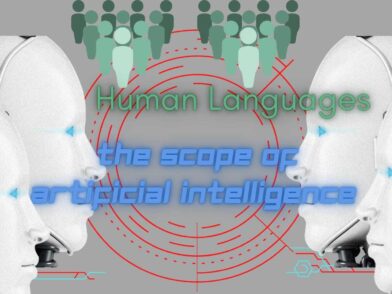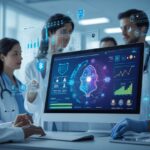Artificial Intelligence (AI) refers to the ability of machines to perform tasks that typically require human intelligence, such as recognizing speech, making decisions, solving problems, and learning. AI systems are designed to perceive their environment, reason about that environment, and take action to achieve a particular goal.
There are several different approaches to building AI systems, including rule-based systems, expert systems, machine learning, and deep learning. Machine learning and deep learning have become increasingly popular in recent years, as they allow AI systems to learn from large amounts of data and improve their performance over time without being explicitly programmed for every task.
AI has many applications across a wide range of industries, including healthcare, finance, transportation, and entertainment. Some of the most well-known examples of AI systems include virtual assistants like Siri and Alexa, autonomous vehicles, and facial recognition systems.
While AI has the potential to revolutionize many aspects of our lives, there are also concerns about the impact of AI on employment, privacy, and security. As such, it is important to continue to develop AI systems in a responsible and ethical manner.
Artificial Intelligence (AI) is a rapidly evolving field that has already transformed many aspects of our daily lives, from virtual personal assistants to autonomous vehicles. The goal of AI is to create intelligent machines that can perform tasks that typically require human intelligence, such as recognizing speech, making decisions, and playing games. In this article, we will explore the current state and application of artificial intelligence and some of its most exciting and innovative expressions, from robotics to natural language processing.
Robotics
Robotics is a field of study that relates to computer science, engineering, and other related fields. Robots are machines that are able to perform a variety of tasks from simple operations to complicated decision-making and problem-solving activities.
Robotics research focuses on developing robots that can sense, perceive, and interact with their environment in a way that is similar to humans. This research includes using sensors to detect environmental stimuli, such as temperature, pressure, or sound, and developing algorithms and control systems to enable robots to respond to this information.
Robotics applications are diverse and widespread, including manufacturing, healthcare, space exploration, agriculture, and military operations. For example, in manufacturing, robots are used to perform tasks such as welding, painting, and assembly. In healthcare, robots assist with surgery and rehabilitation, and in space exploration, robots are used to explore and map new planets and moons.
Robots can be designed to operate autonomously or can be controlled by a human operator. Autonomous robots are programmed to perform a set of tasks without human intervention, while teleoperated robots are controlled by a human operator who provides instructions and feedback in real time.
The development of robotics is continuing to advance rapidly, with new technologies and applications being developed all the time. However, there are also ethical and safety concerns related to the use of robots, particularly in areas such as autonomous weapons and surveillance.
One of the earliest and most popular applications of AI is robotics. Robots have been used in industry for decades to automate repetitive tasks, such as assembly line work. Still, recent advances in AI have enabled robots to become much more sophisticated and capable. Today’s robots are able to perform complex tasks, such as moving and manipulating objects, as well as recognizing and avoiding obstacles.
One of the most impressive examples of AI in robotics is self-driving cars. These vehicles use a combination of sensors, cameras, and machine-learning algorithms to navigate roads and avoid accidents. They have the potential to greatly reduce traffic accidents and improve overall safety on the roads. In addition, self-driving cars can be programmed to optimize fuel efficiency, reduce emissions, and even communicate with other vehicles to coordinate movements on the road.
Another exciting area of AI in robotics is the development of human-like robots. These robots are designed to interact with humans and perform tasks that require social skills and empathy. For example, some human-like robots are being developed to assist with care for the elderly and disabled, providing emotional support and performing tasks such as bathing and feeding.
Natural Language Processing
Natural Language Processing is a branch of computer science and artificial intelligence that focuses on enabling machines to understand, analyze, and generate human language. The goal of NLP is to create computer systems that can perform tasks such as language translation, sentiment analysis, text classification, speech recognition, and language generation.
NLP techniques involve a combination of computational linguistics, machine learning, and deep learning methods. NLP tasks typically involve processing large volumes of text data and using statistical models to extract meaningful information from that data.
Some common NLP applications include:
Language Translation: NLP systems can translate text from one language to another, allowing people to communicate across different languages.
Sentiment Analysis: NLP systems can analyze text data to determine the sentiment behind it, whether it is positive, negative, or neutral.
Text Classification: NLP systems can automatically classify text data into categories, such as news articles, emails, or social media posts.
Speech Recognition: NLP systems can convert spoken language into text, enabling voice-based interfaces for digital assistants and other applications.
Language Generation: NLP systems can generate human-like languages, such as chatbot responses, automated news articles, and personalized product recommendations.
Overall, NLP has the potential to revolutionize the way we interact with computers, making it easier for people to communicate with machines and for machines to understand human language
Another area where AI is making great strides is in natural language processing( NLP). NLP is a subfield of AI that focuses on enabling computers to understand, interpret, and induce mortal language. This has a wide range of operations, from language restatement to sentiment analysis. One of the most common operations of NLP is in virtual particular sidekicks, similar to Siri and Alexa. These systems use NLP algorithms to understand spoken commands and respond with information or perform tasks, similar to setting monuments or playing music. In addition, NLP is also being used in chatbots, which are automated systems that can hold exchanges with guests to give support or information. Another instigative area of NLP is in sentiment analysis. This is the process of automatically determining the emotional tone of a textbook, similar to social media posts or client reviews. Sentiment analysis can be used to gather precious perceptivity about client opinions and preferences, and can also be used to descry and respond to negative comments or complaints. Machine Learning Machine literacy is a subfield of artificial intelligence that focuses on erecting computer systems that can automatically ameliorate their performance on a task over time, without being explicitly programmed. The thing of machine literacy is to develop algorithms and models that can learn patterns and connections from data, and use them to make prognostications or opinions. Machine literacy algorithms can be astronomically distributed into three types supervised literacy, unsupervised literacy, and underpinning literacy. Supervised literacy In supervised literacy, a model is trained on labeled data, where each data point is associated with a given affair or marker. The thing of the model is to learn a mapping between the input features and the affair markers, and also use that mapping to prognosticate the affair for new, unseen data. Unsupervised literacy In unsupervised literacy, a model is trained on unlabeled data, where there’s no given affair or marker. The thing of the model is to discover patterns or structures in the data, similar to clusters of analogous data points or low- dimensional representations of high-dimensional data. underpinning literacy In underpinning literacy, a model learns to make opinions grounded on feedback from its terrain. The model receives prices or corrections grounded on its conduct, and the thing is to learn a policy that maximizes the total price over time. Machine literacy has a wide range of operations, including image and speech recognition, natural language processing, recommendation systems, and independent vehicles. It has the implicit in revising numerous diligence, from healthcare and finance to manufacturing and transportation Machine literacy( ML) is a subset of AI that involves training computers to fete patterns and make prognostications grounded on data. This has a wide range of operations, from image recognition to prophetic conservation. One of the most popular operations of ML is in image recognition, where computers are trained to identify objects and people in images. This technology is used in a variety of operations, similar to security systems, medical imaging, and social media. Another instigative area of ML is prophetic conservation, where machines use literal data to prognosticate when a piece of the outfit is likely to fail. This can help companies reduce time-out and ameliorate overall effectiveness. For illustration, a wind turbine can be fitted with detectors that cover its performance and feed data into a machine-learning algorithm. The algorithm can also dissect the data to prognosticate when the turbine is likely to fail, allowing conservation to be listed in advance and reducing the threat of unanticipated time-out. Artificial Intelligence is a fleetly evolving field that has formerly converted numerous aspects of our diurnal lives. From robotics to natural language processing.











